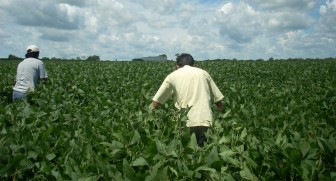ASSUMPTION, Illinois, (Reuters) – Phil Corzine was touring South America as part of an agricultural leadership programme when he saw the future. The third-generation corn and soybean farmer from Illinois in the American Midwest had already visited Chile and Peru when he arrived in Brazil. He was smitten. “For whatever reason it really appealed to me and I said, ‘Boy, I’d really like to find a way to somehow participate down here.’“ That was 13 years ago, long before Brazil became one of the hottest investment destinations in the world and almost a decade before food price inflation started a scramble for agricultural land that last year saw $14 billion invested in the sector.

By 2004, Corzine and a couple of farming friends had teamed up with a Brazilian partner, formed a company, South American Soy, and bought their first land in the central Brazilian state of Tocantins: 2,500 acres (1,000 hectares) at the bargain price of $100 an acre. At the time, an acre in Illinois cost about $5,000.
South American Soy now has 5,000 acres planted; in the past couple of years, the company has become profitable — in part because it now also manages land for other investors including a Swiss investment fund. The sweat Corzine and his colleagues have put into their own land has paid off: on paper, South American Soy is looking at a 140 percent appreciation in the value of the land they own after just under seven years. And that’s before profits from their crops are factored in.
“The variable costs of producing soybeans in Brazil are maybe a little higher or similar to here in the U.S.,” says Corzine, sitting in his house in Illinois on a snowy day late last year. “The real opportunity is finding land at lower cost and building a soybean farm down there at much lower cost than you could do it in here in the States.”
Corzine and his fellow investors are a tiny part of a huge global trend. Land, long ignored by non-farmers as an asset class, has become one of the hottest investments around over the past half decade. When food prices spiked in 2007 and 2008, demand for arable land shot up. Land prices stalled after the credit crunch and global downturn, but another round of food inflation over the past year has fueled new demand and price gains.
A study commissioned by the Organization for Economic Cooperation and Development (OECD) last year estimated that global private sector investment in agriculture hit $14 billion in 2010. This figure could triple in the next five years according to the OECD. The World Bank estimates that 45 million hectares worth of large-scale farmland deals were announced in 2009, more than 10 times the annual average expansion of agricultural land in the decade to 2008. “Demand for land acquisition continues and may even be increasing,” the World Bank said in its report, which asked whether the rush for land can “yield sustainable and equitable benefits?”
It’s a good question. When fast-growing countries in the Middle East and Asia began buying land in Africa four years ago, there were cries of land grab and exploitation. Now hedge funds, pension funds, multinational corporations, farmer cooperatives and other investors are piling in as well, bringing, in some cases, new ideas and more professional management.
But the land rush still poses plenty of dangers: for both the countries targeted for their rich, under-exploited land and for anyone sinking money into a farm halfway around the world. The World Bank calls the risks “immense…At the same time, these risks correspond to equally large opportunities.”
CHANGE OF RULES
Brazil is a case in point. Tens of thousands of investors poured $26 billion in foreign direct investment into the country in 2010. But anyone interested in following Corzine in buying up Brazilian land may find it tough. In August last year, with pragmatic leftist Luiz Inacio Lula da Silva still president, the office of Brazil’s Attorney General issued a new interpretation of a 1971 law on foreign control of Brazilian land. The effect has been to cap at 12,350 acres the amount of land that can be bought by a foreigner or a company that’s more than 50 percent foreign-owned.
Rolando Viera Jr., a Special Advisor in the Brazilian Attorney General’s office, says the change was triggered by 2008’s global food shortage, the need to secure land to produce biofuels and the growing realization that foreigners were buying up “significant parts of the national territory”. Just as other countries define certain industries or assets — ports and airports, communication systems — as strategic, Brazil has decided its land is “a fundamental strategic asset,” Viera told Reuters. “It is a dramatic issue. These are factual circumstances that are present and that impact the life of the country and could mean a great comparative advantage in international trade for Brazil.”

Do Brazil’s restrictions risk chasing away investors? Some analysts are anxious that the new government of Dilma Rousseff could prove even more protectionist. But Erasto Alaimeda, New York-based Latin America analyst at the Eurasia Group, a research firm, says Brasilia is likely to remain open to investors, even if it has tightened up the rules. “One of the big lessons that the Brazilian left … have learned (is) that responsible macroeconomic policies, but also foreign investment, are a precondition for higher rates of growth and that they can benefit a lot politically from that,” he says.
Perhaps. For now, the rule change has investors on edge. Tarcisio Kroetz, a lawyer who represents hedge funds and foreign investors in forest land around the southern Brazilian city of Curitiba says Brazil may miss out on billions of dollars. “Investors are looking for clarity and they are looking for legal assurance that the law is not going to be changed, that the game is not going to be changed in the next few years,” he told Reuters.
Locals who have seen the benefits of foreign money are also worried. Ademar Moacir Cordeiro, a former mayor in Tunas do Parana, a mountain town some two hours southwest of Curitiba, says foreign investment in forestry has brought jobs that pay three times the minimum wage, and a booming local economy. “If there were no forestry industry we wouldn’t be standing here today,” he says, estimating that 200 log-laden 18-wheel trucks trundle through the town on a typical day. “We depend on the planting of the trees… The forestry industry is the future of the town and it’s what we leave for future generations.”
“WE WERE TRICKED”
Uncertainty in Brazil could push more investors towards its neighbors such as Argentina, or to Africa. Philippe de Laperouse, managing director of global food, agribusiness and biofuels at consulting firm HighQuest Partners, estimates that until the foreign ownership decision, as much as 45 percent of investment capital targeting opportunities in farmland had been focused on Brazil. Now that interest “has abated and may be shifting to other regions.”
If it does, there are plenty of potential problems — for both investors and for the countries they’re moving into.
Take the village of Yainkasa, Sierra Leone, which has leased 123,600 acres of land to Addax Bioenergy, part of the privately owned Swiss-based energy firm Addax & Oryx Group. Like the residents of Tunas do Parana, people in Yainkasa would like to ensure the prosperity of future generations — and that may have been their aim when they leased their land. Now, though, villagers say that Addax’s sugarcane crop is much bigger than they had imagined and threatens their food harvests. “We were tricked,” rice farmer Alie Bangura, 68, told Reuters late last year. “We feel the way we’re being treated is not in line with our agreement. They promised things when we gave up our land that didn’t happen.”
Addax says it conducted lengthy consultations with locals and that a large share of the $12 per hectare it paid for the land went directly to local farmers. A development program to improve food yields will ensure villagers have enough to eat. Addax social affairs manager Aminata Kamara told Reuters in November that some of the complaints are based on “ignorance”.
Whatever the truth in this particular case, many experts worry that the rush for land will hurt poor locals. Africa’s vast lands are already the focus of intense attention. From private Western investment funds wanting to farm organic beans in southern Africa to Qatar, which is looking at projects in Sudan, Ethiopia and Eritrea, an eclectic array of investors are lining up to sink hundreds of millions of dollars into the continent.
But the World Bank report says countries in Africa with weak governance, including many with the most sought-after land, are unable to cope with the land rush. “As a result, land acquisition often deprived local people, in particular the vulnerable, of their rights without providing appropriate compensation,” its study last year said. Environmental group Friends of the Earth says the rising demand for biofuel is driving a new “land grab” in Africa.
Such concerns flared in 2008 when a lease by South Korea’s Daewoo for nearly half of the arable land in Madagascar triggered a wave of protests that eventually ousted President Marc Ravalomanana. Last October, a code of principles for “responsible agricultural investment” proposed by the World Bank and U.N. agencies failed to win widespread backing. As corporations and private funds sink billions into land, the risk of exploitation remains, activists say. “We are demanding … a moratorium on large transactions (over 50,000 hectares) which involve foreign investments in farmland in developing countries until there’s adequate, legally binding regulation,” says Soren Ambrose, international policy manager for ActionAid, a charity.
But some in the industry say things are already improving. “Corporate agriculture is lifting management standards on governance and sustainability in agricultural investments,” says Tim Hornibrook, division director at Macquarie Agricultural Funds Management, which manages 3.2 million hectares of Australian farmland on behalf of investors and is considering expanding into other regions. “Corporates cannot afford to do the wrong thing from an environmental and community perspective because of the greater (media) headline risk they carry.”
Reputational risk, says HighQuest Partners’ de Laperouse, “is very important to funds investing due to their investor base. They’re sensitive to being viewed as investors who are transparent and whose activity is a positive development, not a negative one.” That’s one reason why some land investment funds sign up to existing sustainability schemes and certification codes including EUREGAP certification, FAO practices and International Finance Corporation (IFC) environmental and social standards.
Industry players say better transparency will help local communities and investors alike.
“Africa is a large, fragmented market and it’s difficult for many investors to grasp what’s happening. We believe the more transparency you can get in these markets the more investors will understand the opportunities,” says Neil Crowder, managing partner of private equity firm Chayton Capital, which has recently acquired farmland in Zambia.




